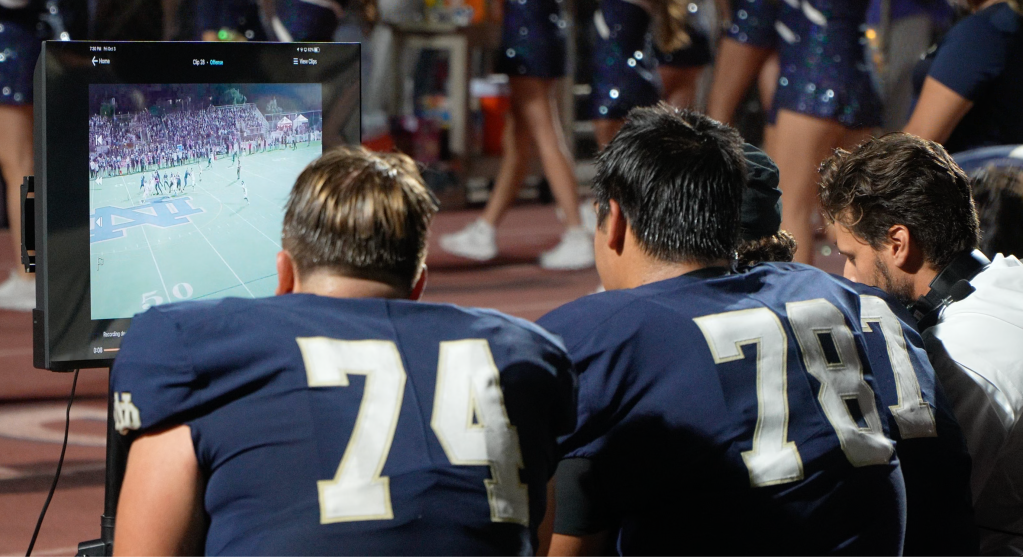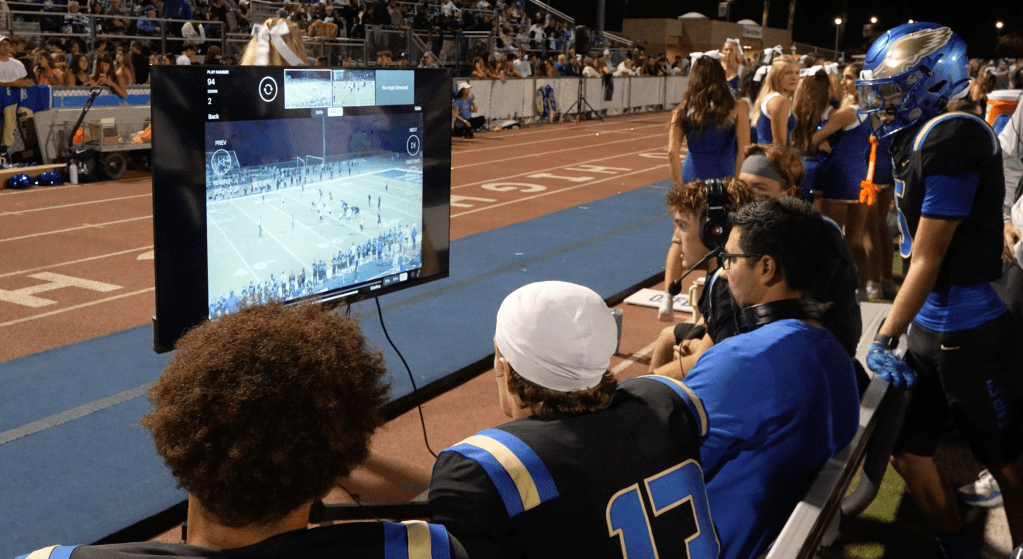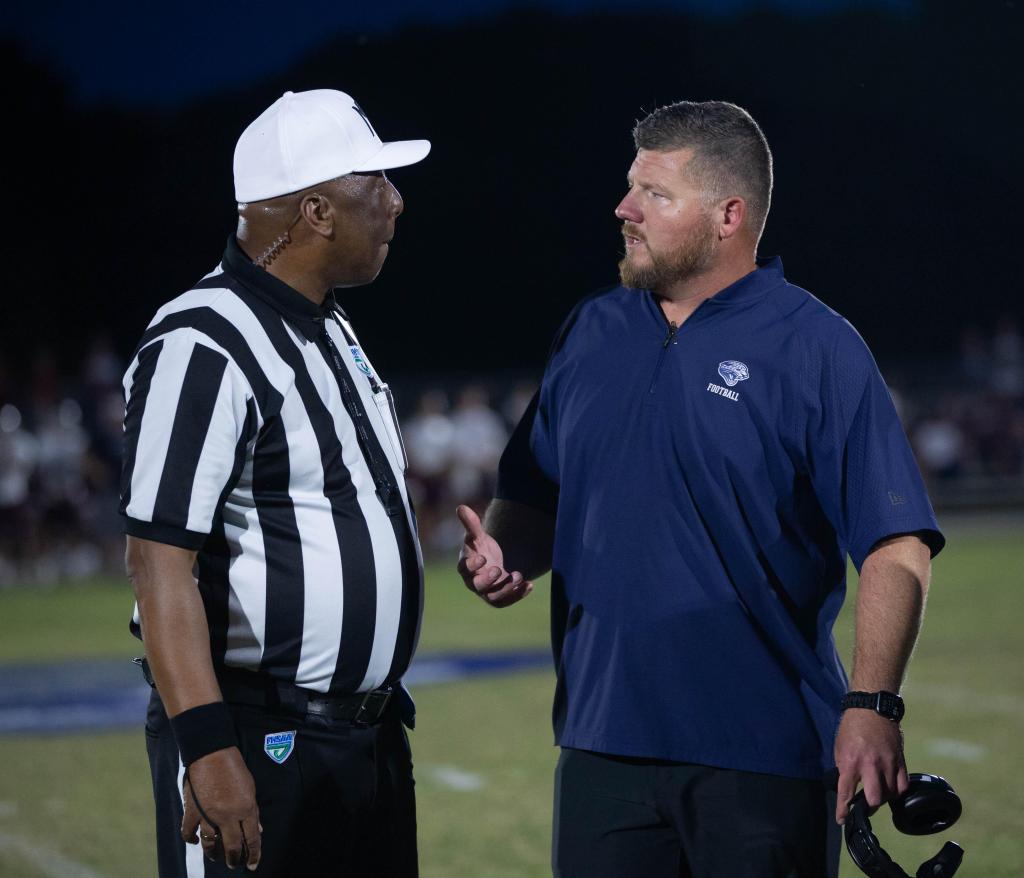Is it Time to Expand Instant Replay in High School Football?
Anwar Stetson

New Tech for an Old Game
High School football still has all the nostalgic Americana that made it one of our nation’s most popular pastimes. This fall, Friday nights are still filled with lights, cheerleaders, youthful exuberance, student sections, and bands.
It’s hard not to be poetic about an institution loved across the country as the weather cools and the leaves change. But high school football is also changing with the times. The sidelines of many high school football games look like a scene out of NFL Films. Players sit on the bench, huddled with their backs turned away from the field and towards the stands–fixated on a large HD TV.
The scene looks more like a college lecture than a high school football game. In every game I’ve covered this season in Southern California, coaches use real-time footage and go over film with players during games. Some schools I’ve covered this year have multiple TVs for film study, used by both the offense and defense. Sometimes the live film sessions are broken down into even smaller groups, like offensive line and linebacker groups.
It’s an incredible technological advantage and has the added benefit of helping players develop mid-game. But the product on the field looks mostly the same as it always has.
A bang-bang play occurs, and a referee gets a call wrong. Vicious parents curse at the refs from the sidelines or come up with sarcastic quips about them being blind or gamblers. The game moves on.

Expanding Instant Replay
I can’t help but note the peculiarity that players and coaches on almost every sideline can watch an instant replay, but the game’s officials don’t have the same access.
The level of talent in high school football today is impressive. It’s becoming increasingly reminiscent of the college game, where instant replay is ingrained and common.
My take? It’s time for expanded instant replay in high school football across the country. But will it happen?
Well, the use of instant replay overall is expanding. The Missouri High School State Athletic Association just became the 17th state to implement instant replay for postseason matchups this offseason. As more states look to introduce instant replay in playoff games, it seems only a matter of time until that technology be adopted for every game.

How It’s Done
The National Federation of State High School Associations (NFHS), is the major governing body that writes rules for high school sports nationwide. Most state athletic associations use their official rules and regulations for their leagues.
Historically, the NFHS has barred the use of video and instant replay. However, over the past 10 years, they’ve started changing their rule book. First, in 2016, they allowed the use of sideline video for coaches. Then, in 2019, NFHS changed the rules again, this time allowing instant replay, or “video review” during the postseason.
Like many aspects of high school sports, the implementation of rules and regulations is not universal. States use NFHS rules, but often have autonomy to pick and choose which rules they will or will not adopt. States don’t have to have instant replay in the postseason, but are allowed to implement it if they choose. And some who have decided to implement instant replay have been the recipients of intense backlash.
Why Replay Isn’t Used in the Regular Season
In 2023, Sandy Creek (Ga.) defeated Cedar Grove (Ga.) after 21-17 in a Georgia State Championship game. The go-ahead touchdown was called even though video replay showed that the scoring Sandy Creek player was short of the goal line. After intense pressure and protest, the Georgia High School State Association approved instant replay in championship games that offseason. But why hasn’t the NFHS allowed replay during the regular season?
NFHS official Mike D’ Ambrosio went over 2025 rules and regulations on the Whistle Talk Podcast in April. He explained that his state of New Jersey was one of the first to adopt instant replay in high school football, and even had a trial run for its use in the regular season.
However, most schools used video systems that only provide two angles (one from the 50-yard-line and the other from the endzone). For many calls, the angles simply aren’t good enough to justify the use of replay in the regular season.
“When you get to your state playoffs, it’s either being held–especially your championship games, they’re typically being held at a neutral site,” D’Ambrosio explained. “Most places are at some type of collegiate site where you do have more cameras and more technology available to you. So that’s why they’re only using it in the postseason and not the regular season.”
A Game of Inches
Some states, schools, and athletic associations are wealthier than others. The needs, resources, and competitiveness of a football program near an urban center in Texas are often different than those of a rural school in New Hampshire. Not every high school football league may be able to provide video technology uniformly to all schools in its league. Some states, frankly, don’t want it.
Tennessee hasn’t implemented instant replay, with coaches saying it wasn’t a priority. A former Tennessee high school sports executive told The Tennessean last year that if regular-season contests can’t have replay, championship games shouldn’t either.
But football is a game of inches. And in this new monetized youth sports landscape, every play, win, and loss matters. The players aren’t just playing to be the big man on campus, or homecoming king, or to hang with their bros anymore. There are scholarships, jobs, and now money on the line.
Not every state has the opportunity to have instant replay. However, high school football is a massive multi-million dollar industry in many areas of the country. The biggest and best football powerhouses have college and NFL-level equipment, training, coaching, and development.
Thus, it seems like a growing necessity for the NFHS to change rules to allow schools to use regular-season instant replay for the benefit of leagues that can use it.